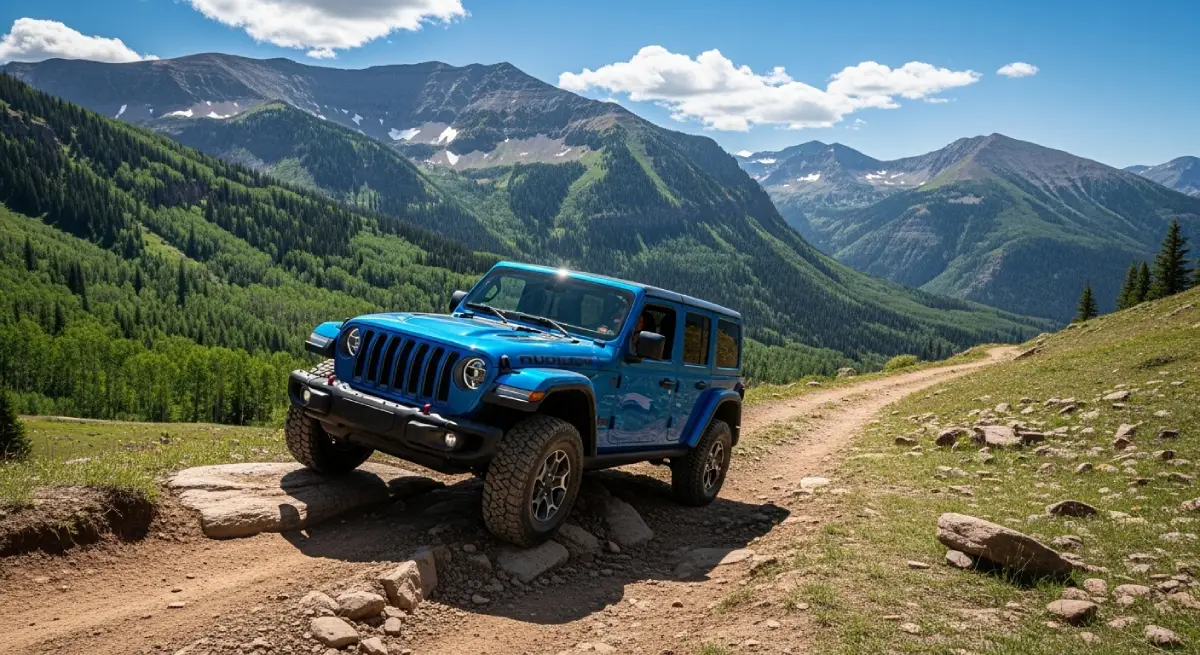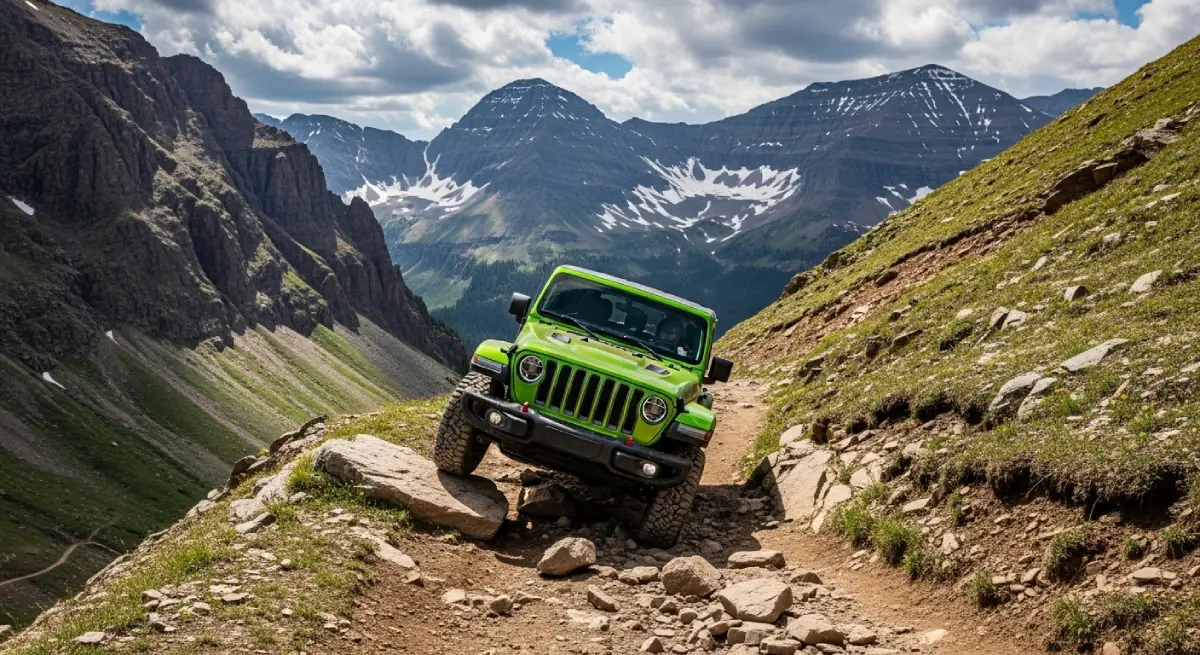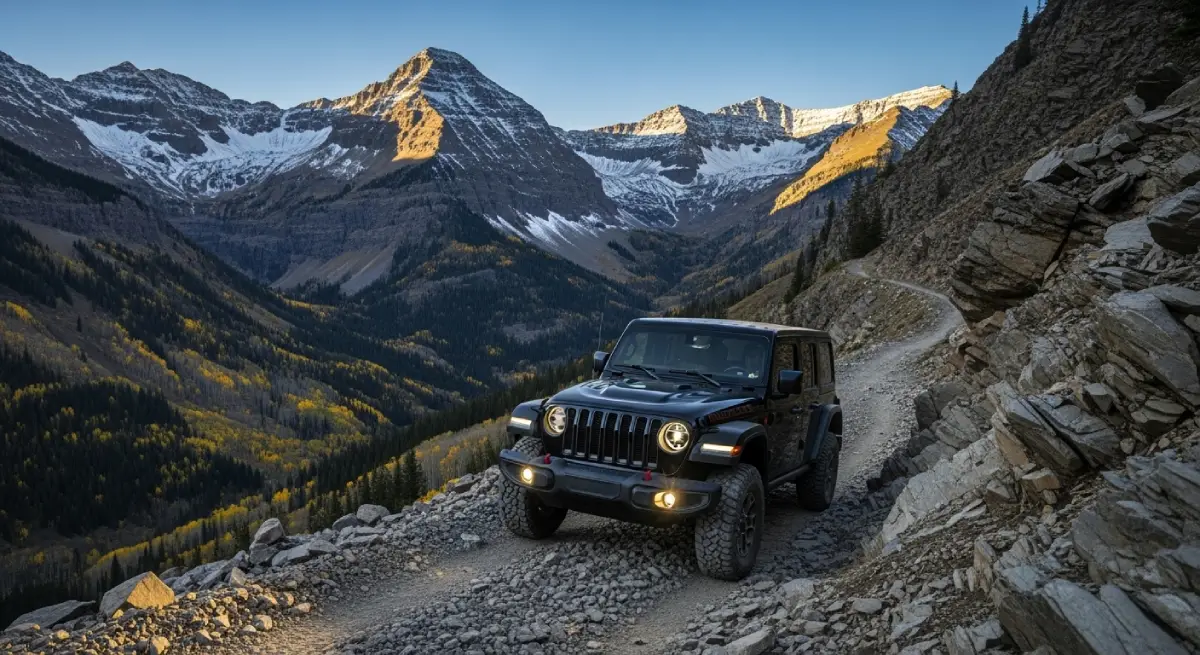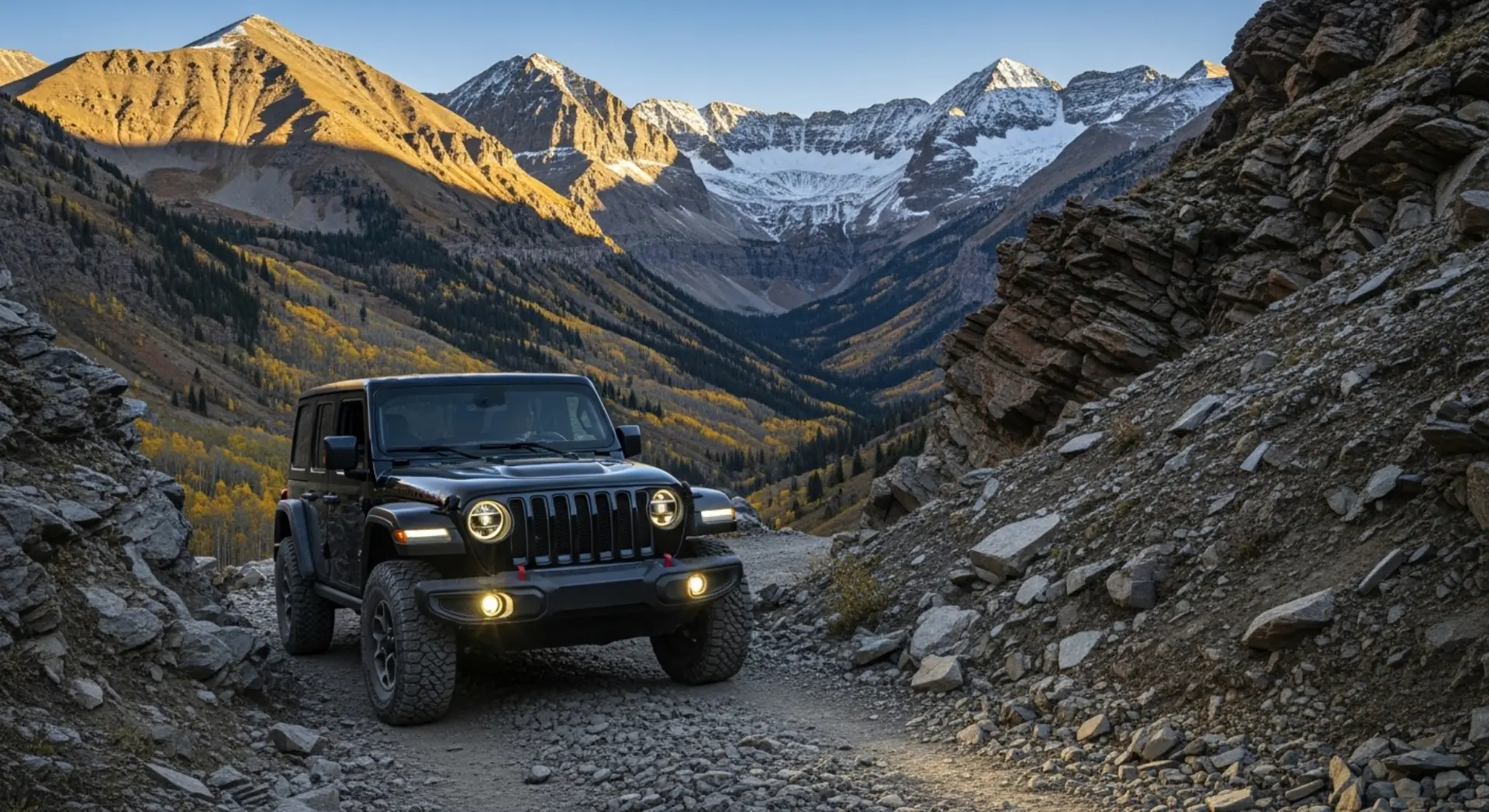Ophir Pass: Colorado's Scenic High-Altitude Gateway That Rewards Preparation Over Luck
Here's what most people miss about Ophir Pass: this isn't just another pretty mountain drive between two famous Colorado towns. At 11,789 feet above sea level, Ophir Pass represents one of the most rewarding high-altitude crossings in the San Juan Mountains—a route that connects Silverton and Telluride through terrain where technical challenges, historical significance, and stunning scenery combine to create experiences that casual tourists never discover.
Ophir Pass operates in that sweet spot between accessible adventure and genuine challenge, where properly prepared vehicles and competent drivers succeed while overconfident tourists with inadequate equipment turn around when reality exceeds their optimistic expectations.

The route follows historical mining roads through terrain that claimed countless wagons and pack trains during Colorado's mining boom, and while modern 4x4 vehicles have clear advantages over 19th-century transportation, the fundamental challenges remain: altitude effects that reduce performance, weather patterns that change from safe to dangerous rapidly, and technical sections that demand skill rather than just courage.
Most people experience maybe 40% of what Ophir Pass actually offers because they approach it as a scenic drive rather than understanding it as a legitimate high-altitude adventure that demands appropriate vehicle preparation, weather awareness, and technical driving competency.
The difference between tourists who complete the crossing and adventurers who truly experience this route comes down to preparation, timing, and understanding that beautiful scenery often masks genuine challenges.
Why Ophir Pass Earned Its Place Among San Juan Classics
Ophir Pass doesn't have the extreme reputation of Black Bear Pass or the benchmark status of Engineer Pass, but it offers something those harder routes don't: the perfect combination of achievement and accessibility that makes it ideal for progressive skill development. Successfully crossing Ophir Pass indicates genuine capability while providing experiences that justify the effort without requiring the extreme modifications and expert-level skills that the hardest San Juan routes demand.
What makes Ophir Pass special among Colorado mountain crossings:
11,789-foot elevation creates real altitude challenges without extreme exposure
Technical sections that teach skills without punishing every mistake catastrophically
Connects two of Colorado's most iconic mountain towns (Silverton and Telluride)
Historical mining significance with accessible remnants and educational opportunities
Stunning scenery that rivals more famous routes while maintaining manageable difficulty
Year-round accessibility window longer than higher, more exposed alternatives
The strategic advantage: Ophir Pass serves as an excellent progression route for drivers building toward harder San Juan challenges. Success here with proper preparation indicates readiness for increasingly technical terrain, while the route itself provides genuine satisfaction rather than just being a stepping stone.
The Elevation Reality at 11,789 Feet
Ophir Pass elevation creates atmospheric conditions that affect vehicle performance and human capability in ways that lower-elevation driving never teaches. While not as extreme as the 12,000+ foot passes, 11,789 feet still places you well above most North American terrain, in atmospheric pressure conditions where standard systems work harder to deliver less performance.
Engine Performance at High Altitude
Power degradation at Ophir Pass summit:
Naturally aspirated engines: 32-36% power reduction compared to sea level
Fuel efficiency: 20-25% decrease due to atmospheric compensation
Cooling system stress: 40-45% increased heat generation on sustained climbs
Transmission temperatures: Elevated significantly during technical sections
Why altitude matters for technical driving: The power loss that makes climbing challenging also reduces your ability to recover from mistakes or navigate obstacles that demand precise throttle control. When engine output drops 35%, your margin for error shrinks proportionally.
Turbocharged performance advantage: Forced induction systems maintain approximately 75-80% of sea-level power output at Ophir Pass elevation, providing significant advantages during technical sections where naturally aspirated engines struggle with reduced output.
Human Performance Considerations
Sea-level residents notice performance effects above 8,000 feet, with symptoms becoming noticeable at Ophir Pass elevation. The reduced oxygen affects cognitive function, reaction time, and physical stamina—all important factors when navigating technical terrain that requires sustained concentration and precise vehicle control.
Altitude effects on driver capability:
Reaction time increases 15-20% compared to sea-level baseline
Decision-making becomes slower when quick adaptation is required
Physical fatigue accumulates faster during extended technical driving
Coordination suffers when precise throttle and steering control matter
Minor altitude symptoms (headache, mild nausea) can affect concentration
The accumulated effect: As the route progresses and fatigue builds, altitude effects compound, making the final technical sections more challenging than they would be at lower elevations even with identical terrain features.
Weather Patterns Across the San Juan Range
Ophir Pass weather operates on San Juan Mountain principles that create rapid changes from comfortable to challenging conditions. The elevation and mountain location create localized weather patterns where afternoon thunderstorms develop quickly and temperature swings of 30-40 degrees within hours are normal rather than exceptional.
Seasonal Access and Conditions
Summer optimal window (July-September): Best conditions for Ophir Pass crossing, though afternoon thunderstorms develop regularly and create lightning hazards on exposed sections. Morning starts before 10 AM provide the best weather stability before daily heating triggers storm development.
Fall color season (September-October): Spectacular autumn aspen colors with increasingly variable weather as winter approaches. Early snow can close the pass suddenly while lower elevations remain clear and accessible. Temperature monitoring becomes critical as conditions fluctuate dramatically.
Winter closure (November-June): Snow accumulation makes Ophir Pass impassable for standard vehicles, with drifts and ice conditions that persist well into late spring at elevation. Winter attempts require specialized equipment and avalanche awareness beyond recreational capabilities.
Spring transition (June-July): Snowmelt creates muddy conditions and stream crossings while patches of snow remain at elevation. Early season access offers solitude but requires flexibility as conditions vary dramatically based on recent weather and snowpack.
Daily Weather Progression
Morning advantages (6 AM - 11 AM):
Stable atmospheric conditions before convective heating triggers storms
Clear visibility with optimal lighting for photography and scenery appreciation
Cooler temperatures that reduce overheating risks on sustained climbs
Minimal thunderstorm probability for safer crossing without lightning exposure
Afternoon challenges (12 PM - 6 PM):
Rapid thunderstorm development creates lightning exposure on elevated terrain
Temperature variations affect vehicle cooling and surface traction conditions
Increased wind speeds that affect vehicle control on exposed ridgeline sections
Higher probability of weather-related discomfort or route complications
Technical Challenges That Define the Route
Ophir Pass combines moderate technical sections with sustained climbing that creates comprehensive challenges without the extreme difficulty that characterizes the hardest San Juan routes. The technical demands teach important skills while maintaining margins for error that allow progressive learning rather than immediate consequences for technique deficiencies.
The Switchback Section Challenge
The series of switchbacks on both sides of Ophir Pass summit require precise vehicle control, appropriate line selection, and understanding of how vehicle dimensions interact with tight radius turns at grade. These turns aren't as extreme as Black Bear Pass, but they demand competent driving and appropriate vehicle modifications for safe navigation.
Switchback navigation requirements:
Adequate turning radius with understanding of vehicle wheelbase limitations
Throttle control that maintains momentum without breaking traction
Awareness of vehicle width and clearance for narrow passage sections
Proper use of low-range gearing to prevent rolling backward on grades
Rock and Loose Surface Sections
Ophir Pass contains rock garden sections and loose surface areas where wheel placement and traction management determine success versus delays or damage. These sections require reading terrain for safe lines while maintaining appropriate speed that balances momentum against control.
Technical terrain management:
Pre-identify wheel placement through rock gardens before committing
Maintain steady throttle application to prevent wheel spin on loose surfaces
Understand vehicle articulation capabilities for uneven terrain navigation
Use spotter assistance when visibility limits safe line identification from driver seat
Stream Crossing Variables
Seasonal runoff creates stream crossings that vary dramatically based on recent weather and time of year. These crossings require assessment of depth, flow rate, and bottom conditions while considering that failed attempts create recovery situations that complicate the adventure.

Water crossing assessment:
Verify depth before committing (water depth should not exceed 18 inches)
Check flow rate and bottom conditions for stability and traction
Identify exit strategy before entry in case conditions exceed expectations
Understand that early season crossings pose greater challenges than late summer
Historical Mining Context That Adds Depth
Ophir Pass preserves significant remnants of Colorado's mining era that provide educational context about why this challenging route mattered to 19th-century miners and how they approached transportation problems in extreme mountain terrain. The historical sites, mining structures, and trail artifacts create exploration opportunities that combine adventure with education.
The Ophir Mining District
The name "Ophir" comes from a legendary biblical place of gold, reflecting the optimism and ambition that drove Colorado's mining boom. The Ophir mining district produced significant silver and gold during the late 1800s, with operations that required transportation routes capable of moving heavy equipment and ore through terrain that challenged both human and animal capabilities.
Historical significance that enhances modern adventure:
Mining structures demonstrate engineering solutions to extreme altitude challenges
Trail artifacts show evolution of mountain transportation over decades
Ghost town remnants provide rest stops and educational opportunities
Historical context explains why certain route choices were made despite difficulty
Engineering Solutions That Inform Modern Travel
The miners and freighters who established Ophir Pass understood that success required careful grade selection, strategic switchback placement, and acceptance that some weather conditions simply couldn't be overcome through determination. These principles remain relevant for contemporary 4x4 adventures.
Historical lessons for modern adventurers:
Careful route planning based on sustainable grades rather than direct approaches
Weather awareness and willingness to delay rather than force passage
Equipment maintenance and preparation for self-sufficiency in isolation
Respect for terrain forces that don't care about schedules or determination
Vehicle Requirements for Ophir Pass Success
Ophir Pass demands specific vehicle capabilities that address high-altitude performance, moderate technical terrain, and emergency preparedness for remote mountain situations. Understanding these requirements prevents problems while ensuring the capability needed for successful crossing.
Ground Clearance and Approach Angles
Minimum clearance specifications:
9+ inches ground clearance measured at lowest point with full load
Approach angles exceeding 30 degrees for rock obstacles and steep sections
Departure angles over 25 degrees to clear obstacles without rear contact
Skid plate protection covering vulnerable undercarriage components
Why adequate clearance matters: Ophir Pass contains rock obstacles, uneven terrain, and technical features that exceed the clearance manufacturers design for highway comfort and suburban parking. Stock vehicles often struggle where properly modified machines succeed.
Traction and Drivetrain Systems
Essential drivetrain capabilities:
4-wheel drive with functional low-range transfer case for technical sections
Aggressive all-terrain tire tread designed for mixed rock and dirt surfaces
Adequate tire pressure adjustment capability for changing terrain conditions
Recovery equipment including tow straps and basic extraction gear
Why all-wheel drive isn't sufficient: AWD systems designed for winter highway driving lack the low-range gearing and robust construction necessary for sustained technical terrain at altitude where reduced power output demands maximum mechanical advantage.
Cooling System Adequacy
High-altitude sustained climbing creates cooling demands that stress systems already compromised by reduced atmospheric pressure. Marginal cooling systems that function at lower elevations often overheat when altitude effects combine with sustained grade climbing.
Cooling system requirements:
Adequate radiator capacity for sustained mountain driving at altitude
Functional cooling fans that work effectively in thinner atmosphere
Real-time temperature monitoring for early warning of overheating conditions
Emergency coolant supplies for unexpected overheating situations
Why Professional Rental Services Make Sense for Ophir Pass
Attempting Ophir Pass in personal vehicles creates complications that professional rental services eliminate: insurance limitations for high-altitude off-road activities, modification costs for occasional use, and lack of current information about seasonal conditions and route status that affect success probability.
Purpose-Built Fleet for San Juan Terrain
Cliffhanger Jeep Rentals operates vehicles designed specifically for San Juan Mountain conditions, with cooling systems, gearing, and protective modifications proven through countless successful Ophir Pass crossings rather than theoretical specifications that sound adequate but haven't been tested.
Fleet specifications for high-altitude success:
Enhanced cooling systems designed for sustained high-altitude operation
Appropriate low-range gearing for technical terrain at reduced power output
Protective modifications based on actual contact patterns from this route
Emergency equipment positioned for remote self-sufficiency when needed
Local Expertise About Current Conditions
Real-time intelligence: Professional operations maintain current information about weather patterns, seasonal road conditions, and temporary hazards that aren't reflected in guidebooks or online resources that may be outdated.

Route optimization: Experienced guides understand the best lines through technical sections, timing strategies that avoid weather complications, and alternate routes when primary approaches face temporary closures or hazards.
Comprehensive Insurance Coverage
Personal vehicle insurance typically excludes coverage for off-road activities at high altitude, leaving owners responsible for recovery costs and repair expenses when Ophir Pass challenges exceed vehicle or driver capabilities—situations more common than optimistic planning assumes.
Professional insurance advantages:
Coverage designed specifically for high-altitude off-road activities
Emergency extraction services when situations exceed self-recovery capability
Mechanical support for failures in remote locations far from standard assistance
No personal financial exposure for damage during appropriate vehicle use
Planning Your Ophir Pass Adventure
Successful Ophir Pass crossings require planning that accounts for altitude effects, technical terrain, and weather variability that creates requirements different from casual mountain drives or lower-elevation adventures.
Optimal Timing Strategy
Early summer access (July-August): Recent snowmelt may create variable conditions, but weather generally remains most stable. Route conditions improve as summer progresses though thunderstorm probability increases with daily heating.
Peak season window (August-September): Optimal conditions with minimal mud and maximum accessibility. Increased traffic creates dust on dry sections but also means more vehicles available for assistance if needed.
Fall color season (September-October): Spectacular autumn scenery with increasingly unpredictable weather. Early snow possible at any time, requiring flexibility and willingness to turn back if conditions deteriorate suddenly.
Group Size and Composition
Optimal configuration: 2-3 vehicles provide safety redundancy without creating coordination challenges on technical sections where communication becomes difficult and progress slows significantly.
Experience requirements: At least one team member should have high-altitude driving experience and familiarity with mountain weather patterns that affect safety decisions and optimal timing.
Emergency Preparedness Requirements
Communication systems: Cell service is unreliable on most of Ophir Pass, making satellite communication devices important rather than optional for groups venturing into remote terrain.
Self-sufficiency essentials:
Navigation systems with offline mapping for GPS signal loss
Emergency shelter for unexpected weather changes at altitude
Water and food supplies exceeding planned duration by 50%
First aid equipment appropriate for remote location emergencies
Basic tools and spare parts for common mechanical issues
The Silverton-Telluride Connection Advantage
Ophir Pass provides the most direct high-country route between two of Colorado's most iconic mountain towns, creating adventure opportunities that combine technical driving with destination appeal. The ability to start in historic Silverton and finish in resort-town Telluride adds context and conclusion that enhances the crossing experience.
Silverton Starting Point
Starting from Silverton provides the advantage of climbing the western approach, which features more gradual grades and technical sections that build skills progressively before the summit and eastern descent. The mining town atmosphere and historical context provide pre-adventure education and appropriate mindset setting.
Telluride Destination Appeal
Finishing in Telluride creates a satisfying conclusion to the adventure, with resort town amenities and celebratory dining options that reward successful crossing. The contrast between remote high-altitude terrain and sophisticated resort atmosphere emphasizes the achievement while providing comfortable recovery.
Environmental Responsibility at High Altitude
Ophir Pass crosses sensitive alpine environments where inappropriate use creates damage requiring decades for recovery. Responsible recreation practices preserve access while protecting ecosystems that exist only at high altitude in Colorado's mountains.
Alpine Environment Protection
Critical protection priorities:
Stay on designated routes to prevent vegetation damage that persists for decades
Pack out all waste including food scraps that attract wildlife and alter behaviors
Avoid camping above treeline where recovery from disturbance is extremely slow
Minimize noise impacts during wildlife sensitive periods
Supporting Trail Maintenance
Ophir Pass requires ongoing maintenance funded by user fees and volunteer support from responsible recreation communities. Supporting trail organizations and complying with fee requirements helps preserve access while funding necessary maintenance.
The Reality of Ophir Pass Success
Ophir Pass rewards preparation while providing feedback about the difference between adequate equipment and hopeful improvisation. Success requires understanding that this route, while more forgiving than extreme San Juan passes, still demands respect for altitude, weather, and terrain that operate according to physical principles unaffected by optimism.
What successful crossing requires:
Vehicle capabilities addressing high-altitude performance demands
Weather awareness and flexible timing for rapid condition changes
Emergency preparedness appropriate for remote mountain situations
Technical driving skills refined through progressive experience
Environmental awareness preserving access through responsible practices
Making the Commitment to Ophir Pass
Ophir Pass represents an excellent introduction to serious San Juan Mountain adventure, offering genuine challenges and spectacular scenery while maintaining margins for learning that extreme routes don't provide. The crossing builds skills and confidence that prepare for increasingly difficult terrain while providing immediate satisfaction and achievement.

Building toward Ophir Pass readiness:
High-altitude driving experience developing understanding of elevation effects
Technical driving skills through progressively challenging terrain
Vehicle preparation addressing specific requirements
Weather awareness appropriate for mountain conditions
Emergency preparedness for remote high-altitude situations
The Professional Advantage: Cliffhanger Jeep Rentals
The choice between attempting Ophir Pass in personal vehicles versus partnering with professional services often determines whether the experience becomes smooth achievement or stressful challenge complicated by equipment or preparation inadequacies.
Professional service advantages:
Purpose-built vehicles with proven high-altitude capabilities
Local expertise about current conditions and optimal timing
Comprehensive insurance for high-altitude off-road activities
Emergency support when situations exceed planned parameters
No long-term ownership costs for specialized equipment
The Bottom Line: Earning Your Ophir Pass Crossing
Ophir Pass doesn't demand the extreme preparation that harder San Juan routes require, but it still tests vehicle capability and driver competency in ways that reward thorough preparation while exposing inadequacies in equipment or planning.
The route provides genuine achievement without catastrophic consequences for minor mistakes, making it ideal for progressive skill development.
The atmospheric and geological forces that make this crossing challenging continue operating according to physical principles that require appropriate responses rather than hopeful determination.
Whether you choose to develop personal capabilities or partner with professional services providing proven equipment and expertise, success depends on matching preparation to actual demands rather than optimistic assumptions about what "should" be sufficient.
The most rewarding Ophir Pass experiences come from appropriate preparation that allows focus on scenery and achievement rather than stress about equipment adequacy or route-finding uncertainty at 11,789 feet above sea level.
Ready to cross between Silverton and Telluride on one of Colorado's most scenic high-altitude routes? Cliffhanger Jeep Rentals provides the specialized vehicles, San Juan expertise, and support systems that transform Ophir Pass from potential challenge into successful achievement connecting two of Colorado's most iconic mountain towns.
Experience Ophir Pass with confidence through Cliffhanger Jeep Rentals—where every vehicle is prepared for challenges that separate scenic achievement from stressful struggle at high altitude.


